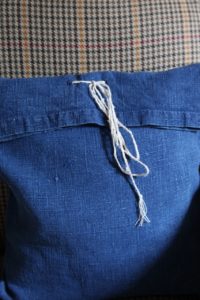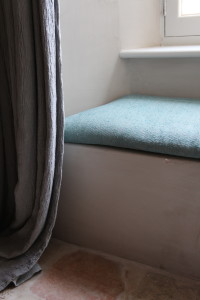The Cannabis sativa plant grown for fibre,oil and seed, which in turn become hemp oil, fabric, paper, resin, wax, fabric, pulp and for building as boarding, insulation and construction blocks.
Though it is as old as the hills, hemp is the ‘new’ material and in addition to its traditional uses for making string, rope, sheets, towelling, awnings and more, it is now being used for building work: blocks, insulation, you name it.. and hemp seems to be behind it
This very simple cushion of indigo dyed hemp with a hemp plaited and hand sewn eyelet closure is the perfect material to use with a very traditional tweed.
Where the plant grows easily and naturally, the stems are 1-4 metres high, it is fast growing, maturing in 3-4 months and the height creates fibres that are long enough to spin and weave
One of the more recently understood factors and interesting uses for hemp in is cleaning soil – it’s dense growth and root system are natural weed suppressants, and it is capable of clearing impurities, effluent and unwanted chemicals from the soil – hemp crops are being used to help clean up the nuclear disaster site at Chernobyl.
The world-leading hemp producers are China, Russia and India, but it is also grown commercially across the world, in predominantly low lying wet areas. These include Australia, Austria, Belgium, Canada, Chile, China, Denmark, Egypt, Finland, France, Germany, England, Hungary, India, Ireland, Italy, Japan, Korea, Netherlands, New Zealand, Poland, Portugal, Romania, Russia, Slovenia, Spain, Sweden, Switzerland, Thailand, Turkey and Ukraine. Which is not surprising as in the past the most rural farming areas that could grew hemp did, even depended on it, if only for their own use.
The crop is harvested in early to mid summer, the plants cut, bundled and stooked or laid on the ground to dry for approx. four days. The bundles were then retted – i.e. soaked in water, either in heavy dew, streams, or water baths in order to soften the fibres by a combination of moisture, moulds and bacterial action. This is still done for small crops, for large crops a process known as thermomechanical pulping is used to both soften, using steam , and separate the fibres.
Hemp is coarser than linen but carries with the same inherent properties, requiring the same processing techniques from growing through to finishing.
Woven hemp cloth softens with washing and makes for highly absorbent and aesthetically pleasing hand, hammam and tea towels. The natural colours vary with each batch.
We use it for curtains, blinds and summer sofa covers. Hemp can also be used for shower curtains, because it absorbs the water and dries out in a couple of hours–it’s so much nicer than glass or any other water -proof material. It does helps if the floor is waterproof as well, but if not, lay a hemp mat close by to catch any overspill.
As well as grain and flour sacks Antique French hemp comes in narrow cloth, possibly made for hand towels and this too is perfect for home furnishings, especially for loose covers and flat window coverings. Antique hemp on the chair, tablecloth and cushions creates a calm, chic environment; the variations in dyes are subtle enough in tones to bring life to the textiles.
 Hemp bags – one a flour sack off cut and the other a newly woven French stripe used at home for our lovely keeping-the-bread-warm bread bags. Instructions at:https://designandmake.net/product/bread-bag/
Hemp bags – one a flour sack off cut and the other a newly woven French stripe used at home for our lovely keeping-the-bread-warm bread bags. Instructions at:https://designandmake.net/product/bread-bag/
Here the window seat cushion is made of hemp in a hardwearing contemporary weave, that is light and bright whilst retaining the feeling of an agricultural heritage. To get the instructions for this project go to : https://designandmake.net/product/window-seat/


